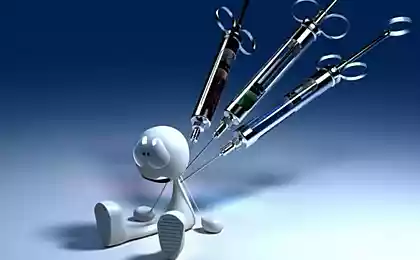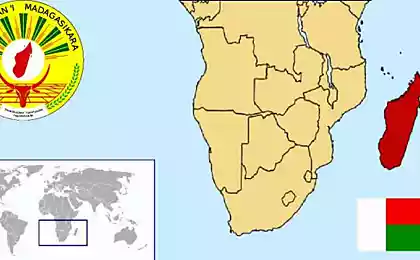700
Cellular inside
Reports about the device and the mobile operator from Sergei Shares
Do you know what happens after you dial another on a mobile phone? As cellular network finds it in the mountains or on the coast of Andalusia distant Easter Island? Why is it sometimes suddenly interrupted the conversation? Last week I visited the company Beeline and tried to figure out how to construct the cellular ...
23 photos

A large area populated part of the country is covered by a base station (BS). In the field, they look like the red and white tower, and the city hidden on the roofs of residential houses. Each station catches the signal from the mobile phone at a distance of 35 kilometers and communicates with a mobile phone on business or voice channels.

Once you dial another, your phone is associated with your nearest base station (BS) for service channel and requests to allocate a voice channel. The base station sends a request to the controller (BSC), and forwards it to the switch (MSC). If your friend is a subscriber of the same network, the Switch check with the Home Location Registor (HLR), to find out where is currently calling (homes in Turkey or in Alaska), and transfer the call to the appropriate switch, where one of his will forward to the controller and then to the base station. The base station will be contacted by mobile phone and connect you to the other. If your friend is a subscriber of another network or a phone call to the landline telephone, your switch will turn to the appropriate switch on another network.
Complicated? Let's look in more detail.
The base station is a couple of iron cabinets, locked in a well-conditioned space. Given that Moscow was on the street 40, I wanted to live in this little room. Typically, a base station or in the attic of the building, or in a container on the roof:

A base station is divided into several sectors, each of which is the "light" in their favor. Vertical antenna communicates with the phone, round the base station connects to the controller:

Each sector can support up to 72 calls simultaneously, depending on the setup and configuration. The base station may consist of 6 sectors, thus, one base station can handle up to 432 calls, however, are usually found at the station transmitters and fewer sectors. Mobile operators prefer to bet more BS to improve the quality of communication.
The base station can operate in three bands:
900 MHz - the signal at that frequency spreading further and penetrate buildings better
1800 MHz - signal travels shorter distances, but it allows you to set a larger number of transmitters on one sector
2100MHz - Network 3G
Here is the case with 3G equipment:

At the base station in the fields and villages set transmitters 900 MHz, and in the city, where the base station as a needle stuck at hedgehog substantially communication is 1800 MHz, although any base station transmitters may be present all three bands simultaneously.

07

The signal frequency of 900 MHz can beat up to 35 kilometers, although the "distance" of some base stations stand along the route can reach up to 70 kilometers, by reducing the number of concurrent users on the station twice. Accordingly, our phone with its small built-in antenna and can transmit a signal over a distance up to 70 kilometers ...
All base stations are designed in such a way as to provide optimal coverage of the radio signal at the ground level. Therefore, despite the distance of 35 kilometers on the aircraft altitude signal is simply not sent. However, some airlines have begun to be installed on its aircraft low-power base stations that provide coverage inside the aircraft. This BS is connected to a terrestrial cellular network via satellite channel. The system is complemented by a control panel that allows the crew to turn on and off the system, as well as certain types of services, such as voice off on night flights.
Telephone can measure the signal strength from 32 base stations simultaneously. Information about the 6 best (level signal), it sends an overhead channel, and has a controller (BSC) decides which BS transfer the current call (Handover), if you're on the move. Sometimes the phone can make a mistake and throw you to the BS with the worst signal, in which case the call may be interrupted. It may also be that a base station that picked your phone, all the voice lines are busy. In this case, as the conversation is interrupted.
I also talked about the so-called "problem of the upper floors." If you live in a penthouse, sometimes, during the transition from one room to another, the conversation may be interrupted. This is because the phone in one room can "see" one BS, and the second - the other, if it comes to the other side of the house and, with these two base stations are at a great distance from each other and are not registered as " neighboring "from the cellular operator. In this case, the transfer of a call from one BS to another will not occur:

Communication is provided in the underground as well as on the street: Base Station - the controller - switch, with the only difference being that there are used small base station and the tunnel cover is provided not a conventional antenna, and special radiating cable.
As I wrote above, a BS can produce up to 432 calls simultaneously. Usually this power enough for the eyes, but, for example, during some holidays BS can not cope with the number of people willing to call. Usually this happens in the New Year when all begin to congratulate each other.
SMS are sent by official channels. On March 8 and 23 February people prefer to greet each other with the help of SMS, sending funny poems, and phones often can not negotiate with the BS to allocate a voice channel.
They told me an interesting case. From one district of Moscow began to receive complaints from customers that they can not reach anywhere. Technicians began to understand. Most voice channels were available, and all service were occupied. It turned out that next to this BS was an institution in which the exams and the students were constantly exchanging text messages.
Long SMS phone divides into several short and sends each separately. Technical Staff are advised to send greetings via MMS. It will be faster and cheaper.
From the base station gets the call to the controller. It looks as boring as BS itself - it is simply a set of cabinets:

Depending on the equipment, the controller can handle up to 60 base stations. The connection between the BS and the controller (BSC) can be obtained through radio-relay link or optics. The controller manages the operation of radio stations, including controls the movement of the called party, transmitting a signal from one BS to another.
Much more interesting is as a switch:

11

Each switch services from 2 to 30 controllers. He has been a great room, cluttered closets with different equipment:

13

14

The switch controls the traffic. Remember the old movies where people first dial up "girls," and then she had to connect them to the other party, peretykivaya wiring? The same deal with switches and contemporary:

To monitor the network at Beeline have several cars that they affectionately called "hedgehogs". They move around the city and measure the signal strength of its own network, as well as the level of a network of colleagues from the "Big Three»:

The entire roof of the vehicle studded with antennas:

Inside the equipment is performing hundreds of calls and removes information:
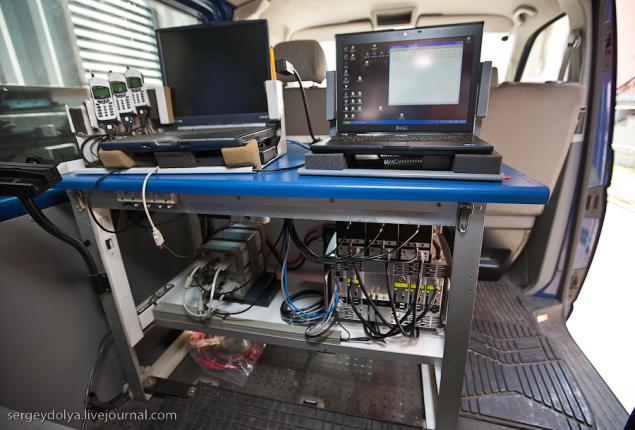
Convenience control switches and controllers is carried out from the Mission Control Center Network Control Center (SCC):
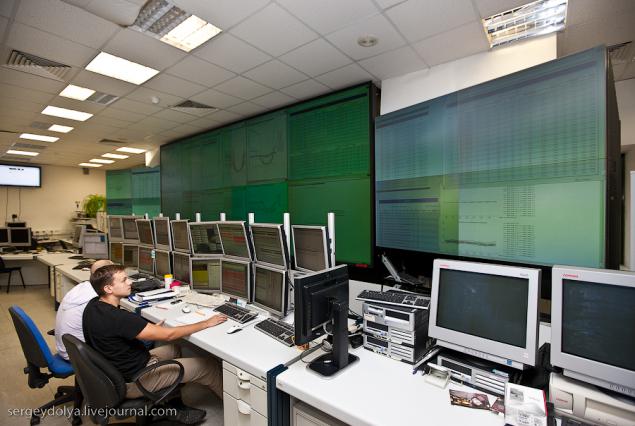
There are 3 main areas to monitor the cellular network: accident statistics and feedback from customers.
Just as in the aircraft, all the network equipment are sensors that send a signal to the MSC and outputting the data to the computer controllers. If some equipment out of order, then the monitor will start "blinking light".
CFB also tracks statistics on all the switches and controllers. He analyzes it, comparing it with the previous period (hour, day, week, etc.). If the statistics are some of the nodes become dramatically different from previous indicators on the monitor again will "blink light».
The feedback received by the operators of subscriber service. If they can not solve the problem, the call is transferred to a technician. If he turns out to be impotent, the company created an "incident" that decide engineers engaged in the operation of the corresponding equipment.
For switches clock watch on 2 Engineer:

The graph shows the activity of the Moscow switch. It is clearly seen that night, almost no one calls:
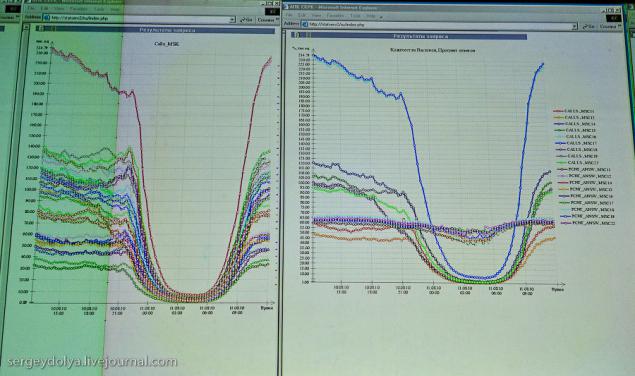
Control of the controllers (pardon the tautology) is carried out from the second floor of the Center Control Network:

23

Source:
Do you know what happens after you dial another on a mobile phone? As cellular network finds it in the mountains or on the coast of Andalusia distant Easter Island? Why is it sometimes suddenly interrupted the conversation? Last week I visited the company Beeline and tried to figure out how to construct the cellular ...
23 photos

A large area populated part of the country is covered by a base station (BS). In the field, they look like the red and white tower, and the city hidden on the roofs of residential houses. Each station catches the signal from the mobile phone at a distance of 35 kilometers and communicates with a mobile phone on business or voice channels.

Once you dial another, your phone is associated with your nearest base station (BS) for service channel and requests to allocate a voice channel. The base station sends a request to the controller (BSC), and forwards it to the switch (MSC). If your friend is a subscriber of the same network, the Switch check with the Home Location Registor (HLR), to find out where is currently calling (homes in Turkey or in Alaska), and transfer the call to the appropriate switch, where one of his will forward to the controller and then to the base station. The base station will be contacted by mobile phone and connect you to the other. If your friend is a subscriber of another network or a phone call to the landline telephone, your switch will turn to the appropriate switch on another network.
Complicated? Let's look in more detail.
The base station is a couple of iron cabinets, locked in a well-conditioned space. Given that Moscow was on the street 40, I wanted to live in this little room. Typically, a base station or in the attic of the building, or in a container on the roof:

A base station is divided into several sectors, each of which is the "light" in their favor. Vertical antenna communicates with the phone, round the base station connects to the controller:

Each sector can support up to 72 calls simultaneously, depending on the setup and configuration. The base station may consist of 6 sectors, thus, one base station can handle up to 432 calls, however, are usually found at the station transmitters and fewer sectors. Mobile operators prefer to bet more BS to improve the quality of communication.
The base station can operate in three bands:
900 MHz - the signal at that frequency spreading further and penetrate buildings better
1800 MHz - signal travels shorter distances, but it allows you to set a larger number of transmitters on one sector
2100MHz - Network 3G
Here is the case with 3G equipment:

At the base station in the fields and villages set transmitters 900 MHz, and in the city, where the base station as a needle stuck at hedgehog substantially communication is 1800 MHz, although any base station transmitters may be present all three bands simultaneously.

07

The signal frequency of 900 MHz can beat up to 35 kilometers, although the "distance" of some base stations stand along the route can reach up to 70 kilometers, by reducing the number of concurrent users on the station twice. Accordingly, our phone with its small built-in antenna and can transmit a signal over a distance up to 70 kilometers ...
All base stations are designed in such a way as to provide optimal coverage of the radio signal at the ground level. Therefore, despite the distance of 35 kilometers on the aircraft altitude signal is simply not sent. However, some airlines have begun to be installed on its aircraft low-power base stations that provide coverage inside the aircraft. This BS is connected to a terrestrial cellular network via satellite channel. The system is complemented by a control panel that allows the crew to turn on and off the system, as well as certain types of services, such as voice off on night flights.
Telephone can measure the signal strength from 32 base stations simultaneously. Information about the 6 best (level signal), it sends an overhead channel, and has a controller (BSC) decides which BS transfer the current call (Handover), if you're on the move. Sometimes the phone can make a mistake and throw you to the BS with the worst signal, in which case the call may be interrupted. It may also be that a base station that picked your phone, all the voice lines are busy. In this case, as the conversation is interrupted.
I also talked about the so-called "problem of the upper floors." If you live in a penthouse, sometimes, during the transition from one room to another, the conversation may be interrupted. This is because the phone in one room can "see" one BS, and the second - the other, if it comes to the other side of the house and, with these two base stations are at a great distance from each other and are not registered as " neighboring "from the cellular operator. In this case, the transfer of a call from one BS to another will not occur:

Communication is provided in the underground as well as on the street: Base Station - the controller - switch, with the only difference being that there are used small base station and the tunnel cover is provided not a conventional antenna, and special radiating cable.
As I wrote above, a BS can produce up to 432 calls simultaneously. Usually this power enough for the eyes, but, for example, during some holidays BS can not cope with the number of people willing to call. Usually this happens in the New Year when all begin to congratulate each other.
SMS are sent by official channels. On March 8 and 23 February people prefer to greet each other with the help of SMS, sending funny poems, and phones often can not negotiate with the BS to allocate a voice channel.
They told me an interesting case. From one district of Moscow began to receive complaints from customers that they can not reach anywhere. Technicians began to understand. Most voice channels were available, and all service were occupied. It turned out that next to this BS was an institution in which the exams and the students were constantly exchanging text messages.
Long SMS phone divides into several short and sends each separately. Technical Staff are advised to send greetings via MMS. It will be faster and cheaper.
From the base station gets the call to the controller. It looks as boring as BS itself - it is simply a set of cabinets:

Depending on the equipment, the controller can handle up to 60 base stations. The connection between the BS and the controller (BSC) can be obtained through radio-relay link or optics. The controller manages the operation of radio stations, including controls the movement of the called party, transmitting a signal from one BS to another.
Much more interesting is as a switch:

11

Each switch services from 2 to 30 controllers. He has been a great room, cluttered closets with different equipment:

13

14

The switch controls the traffic. Remember the old movies where people first dial up "girls," and then she had to connect them to the other party, peretykivaya wiring? The same deal with switches and contemporary:

To monitor the network at Beeline have several cars that they affectionately called "hedgehogs". They move around the city and measure the signal strength of its own network, as well as the level of a network of colleagues from the "Big Three»:

The entire roof of the vehicle studded with antennas:

Inside the equipment is performing hundreds of calls and removes information:

Convenience control switches and controllers is carried out from the Mission Control Center Network Control Center (SCC):

There are 3 main areas to monitor the cellular network: accident statistics and feedback from customers.
Just as in the aircraft, all the network equipment are sensors that send a signal to the MSC and outputting the data to the computer controllers. If some equipment out of order, then the monitor will start "blinking light".
CFB also tracks statistics on all the switches and controllers. He analyzes it, comparing it with the previous period (hour, day, week, etc.). If the statistics are some of the nodes become dramatically different from previous indicators on the monitor again will "blink light».
The feedback received by the operators of subscriber service. If they can not solve the problem, the call is transferred to a technician. If he turns out to be impotent, the company created an "incident" that decide engineers engaged in the operation of the corresponding equipment.
For switches clock watch on 2 Engineer:

The graph shows the activity of the Moscow switch. It is clearly seen that night, almost no one calls:

Control of the controllers (pardon the tautology) is carried out from the second floor of the Center Control Network:

23

Source:











